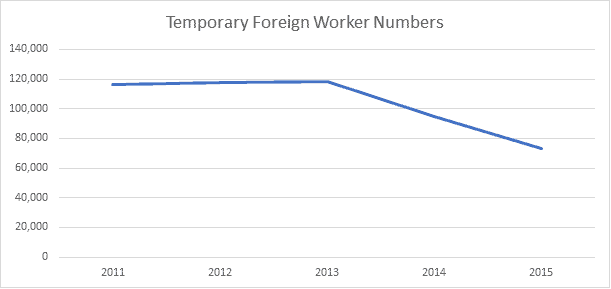[row]
[znhg_column size=”col-sm-6″]
Article Audio:
[/znhg_column]
[/row]
January 9, 2017 – Federal government enforcement of Temporary Foreign Worker Program (TFWP) rules has been criticised because only three businesses have faced penalties since new powers were introduced.
Despite Immigration, Refugees and Citizenship Canada engaging in nearly 1,000 investigations since enforcement rules were changed in December 2015, little action has been taken.
Half of the mainly document-based investigations are ongoing, with some involving site visits. Employment and Social Development Canada has also conducted more than 2,000 investigations of its own.
Read More
Immigration Manual: Processing Live-In Caregivers in Canada
Critics say the changes were only introduced by the previous Conservative government to convince people something was being done to crack down on the program, which had seen a number of high profile violations.
Those found not adhering to TFWP rules are subject to administrative money penalties (AMPs) of up to $100,000 per violation to a maximum of $1 million in any one-year period.
Employers can also be banned from using the program for one, two, five or 10 years, or permanently in the most serious cases.
The rules also apply to the International Mobility Program (IMP), a spin-off from TFWP which includes intra-company transfers and free-trade agreement work permit categories.
Banned employers are also ‘named and shamed’ on the federal government’s website.
The Steps to a Canadian TFWP Visa (each step is fully explained here)
- Determine if you require a work permit to work in your desired job in Canada
- Determine if you are eligible to apply for a Canadian temporary work permit
- Determine if you will apply online or on paper
- Obtain a positive Labour Market Impact Assessment (LMIA) from your potential employer, if required
- Obtain a temporary job offer from your potential employer
- Gather required documents and forms
- Pay fees
- Submit application
It means that employers wishing to use TFWP need to be extremely careful when navigating the process of bringing in a foreign worker using the program. Then, once the workers have arrived, employers also need to be careful they are treated properly.
Violations can include not making enough effort to hire a Canadian to do the job, not being able to produce documents for inspection or making the temporary worker do a different job to the one offered.
In the case of a live-in caregiver, the violations include not providing adequate accommodation.
There were several high-profile cases of the program being abused under the previous Conservative government, leading to sweeping reforms being introduced in 2014.
The reforms created the IMP and raised the cost of a Labour Market Impact Assessment (LMIA) – the document needed to prove no Canadian is available to do the job – from $250 to $1,000.
Further changes saw caps put in place designs to eventually reduce the number of foreign workers to 10 per cent of a company’s workforce. This was slated to be introduced on July 1, but the Liberals stepped in at the last minute to keep the cap at 20 per cent.
As a result of the Conservative changes, the numbers of temporary workers in Canada were dramatically reduced, from almost 120,000 in 2013 to under 75,000 in 2015.

The 2014 changes also included the power to conduct random on-site inspections and compliance reviews, plus make employers hand over payroll records.
Where a preliminary finding of non-compliance is made, an employer has 30 days to respond. Until a final determination is made, pending LMIA applications will be suspended.
A final determination is made after a review of all factors. Where a negative finding is made (that does not result in a ban), employers cannot use the program until the AMP is paid or an agreement is reached.
Employers can appeal a decision via judicial review before the Federal Court.
TFWP Changes Expected
Several changes to the TFWP are expected in 2017, following a Standing Committee report that made 21 recommendations in relation to the program.
IRCC already abolished the cumulative duration rule in December 2016, which previously meant workers in Canada for four years under TFWP could not be granted a work permit in the next four years.
Among other changes, a work force cap of 10 per cent will be maintained for employers who began using TFWP after June 20, 2014. Those who have been using since before then will be capped at 20 per cent.
The government also plans to put further measures in place to ensure TFWs are not being brought in to take jobs away from Canadians.
Low-wage employers will be required to advertise positions to under-represented groups including young people, those with disabilities, Indigenous people and new immigrants.
These changes are yet to come into effect, with the government saying it will notify employers when they do.
Interested employers: Kindly contact us here to receive further information.
Interested candidates: Find out whether you qualify to Canada by completing our free on-line evaluation. We will provide you with our evaluation within 1-2 business days.
Read more news about Canada Immigration by clicking here.




